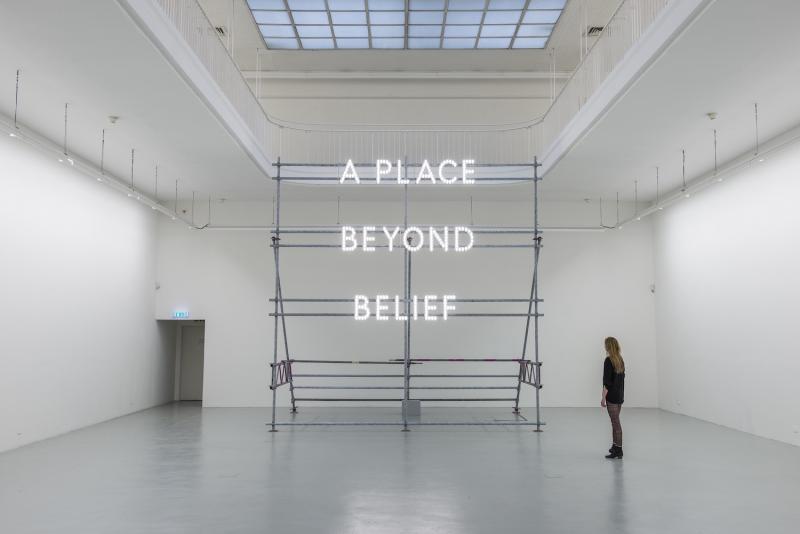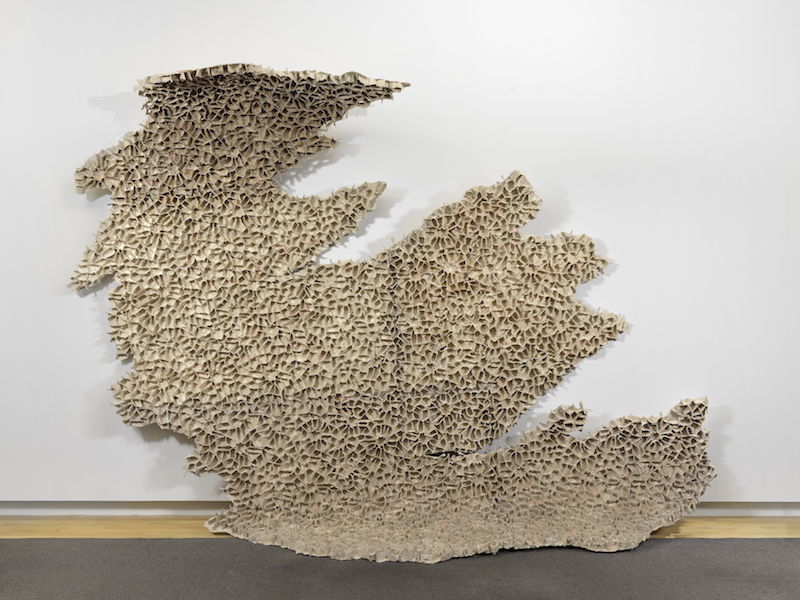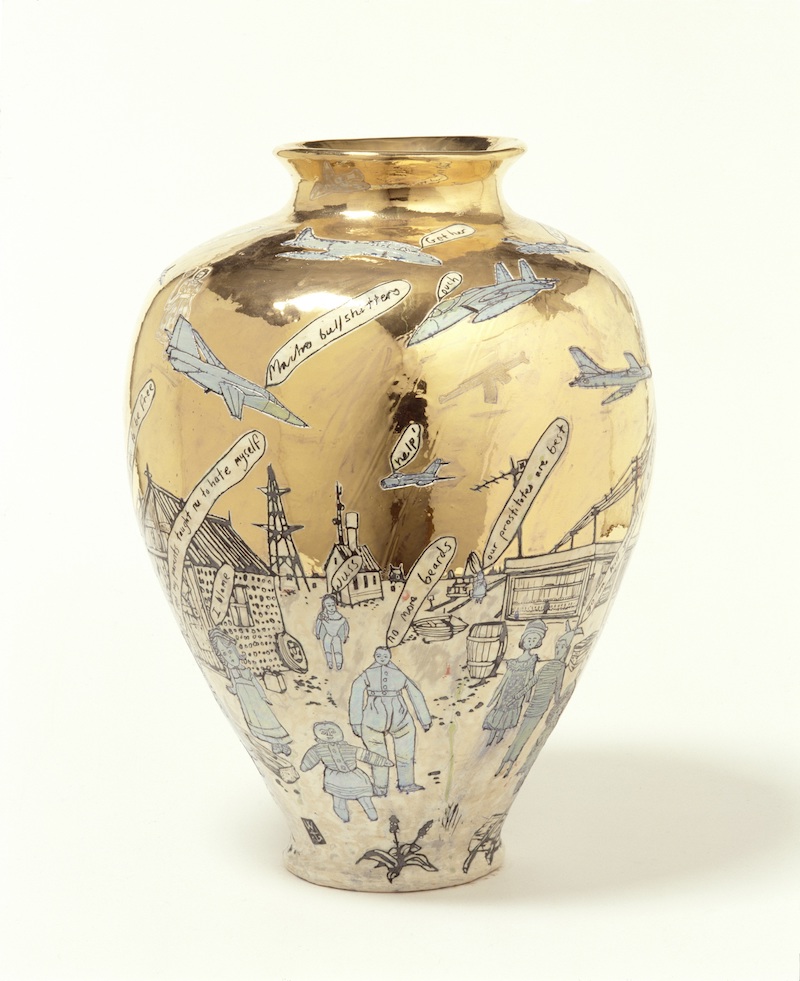Age of Terror: Art Since 9/11, Imperial War Museum review - affecting but incoherent | reviews, news & interviews
Age of Terror: Art Since 9/11, Imperial War Museum review - affecting but incoherent
Age of Terror: Art Since 9/11, Imperial War Museum review - affecting but incoherent
Artistic response to terrorism works best in tiny vignettes

The Imperial War Museum’s Age of Terror: Art since 9/11 brings together art made in response to the immediate events and long-term consequences of the events of 11 September.
Since the purpose of the artworks in each of the sections is to flesh out the allotted topic, the significance of each piece is fixed: meaning is hollowed out, questions are closed down. Propaganda works this way. But the exhibition is more haphazard than proselytising, though it offers unsettling glimpses of the easy transgression between art which carries its own meanings, and art which becomes the instrument of external meanings.
 The fear of inept or malign use is a live and very real concern for contemporary artists working out of today’s conflicts, yet how an exhibition which begins with the events of 9/11 concludes with Syria’s intractable civil war (Hrair Sarkissian’s dual screen film Homesick, 2014) is never made clear, and the inclusion of works by Taryn Simon and Ai Weiwei which speak of American gun culture and Chinese state surveillance are at best missteps and, at worst, wilful elisions.
The fear of inept or malign use is a live and very real concern for contemporary artists working out of today’s conflicts, yet how an exhibition which begins with the events of 9/11 concludes with Syria’s intractable civil war (Hrair Sarkissian’s dual screen film Homesick, 2014) is never made clear, and the inclusion of works by Taryn Simon and Ai Weiwei which speak of American gun culture and Chinese state surveillance are at best missteps and, at worst, wilful elisions.
Curatorial unease aside, many of the pieces on show are eloquent. Walid Siti’s sculpture Floodland, 2017 (pictured above right), reminds us how decades of conflict erode beauty, stability, and identity, and how lives become as blasted as walls, ceilings, floors. Bomb Iraq, 2005, by Cory Arcangel references the intersection of video games and airstrikes in the context of the Gulf War and sheds light on current drone deployment policy. Iván Navarro’s The Twin Towers, 2011, carefully commemorates the lives lost in the World Trade Center towers while touching on events that continue to lead us down a dark and unfathomable future.
 Equally powerful are the first few rooms which deal with artists’ responses to 11 September itself. A print of a painting by Gerhard Richter (September, 2009) which he considered destroying hangs opposite a vase by Grayson Perry (pictured left: Dolls at Dungeness, September 11th, 2001, 2001) — a piece as tasteless as it is honest about a day as terrible as it was surreal. Both artists ask what — if any — power art has in the context of the unspeakable. But what really stands out is New York artist Tony Oursler’s documentary (9/11, 2001). Lingering shots return to empty sky where the towers once stood, and snatched video of the saddened city reeling — multicultural, multiethnic, multilingual, pluri-religious — track how the trauma that provoked donations of money, blood, time and food began to curdle into vituperation, hate.
Equally powerful are the first few rooms which deal with artists’ responses to 11 September itself. A print of a painting by Gerhard Richter (September, 2009) which he considered destroying hangs opposite a vase by Grayson Perry (pictured left: Dolls at Dungeness, September 11th, 2001, 2001) — a piece as tasteless as it is honest about a day as terrible as it was surreal. Both artists ask what — if any — power art has in the context of the unspeakable. But what really stands out is New York artist Tony Oursler’s documentary (9/11, 2001). Lingering shots return to empty sky where the towers once stood, and snatched video of the saddened city reeling — multicultural, multiethnic, multilingual, pluri-religious — track how the trauma that provoked donations of money, blood, time and food began to curdle into vituperation, hate.
Likewise, Nathan Coley’s luminous A Place Beyond Belief, 2012, deals with the loss of what seemed a more innocent world. It references a young woman’s account of how a Sikh man on the subway, affected by the palpable sense of hatred emanating from other commuters, left the subway sobbing. Deeply shaken, she concluded the city needed to "get to a place beyond belief" before it could heal.
The power of this exhibition resides not in grand statements about the impact of that day and the calamitous consequences with which we still live, but in the tiny vignettes which remind us how personal and permanent are the changes wrought by violence, conflict, and war — all the world over.
- Age of Terror: Art Since 9/11 is at the Imperial War Museum until 28 May 2018
- More visual arts reviews on theartsdesk
rating
Share this article
The future of Arts Journalism
You can stop theartsdesk.com closing!
We urgently need financing to survive. Our fundraising drive has thus far raised £49,000 but we need to reach £100,000 or we will be forced to close. Please contribute here: https://gofund.me/c3f6033d
And if you can forward this information to anyone who might assist, we’d be grateful.

Subscribe to theartsdesk.com
Thank you for continuing to read our work on theartsdesk.com. For unlimited access to every article in its entirety, including our archive of more than 15,000 pieces, we're asking for £5 per month or £40 per year. We feel it's a very good deal, and hope you do too.
To take a subscription now simply click here.
And if you're looking for that extra gift for a friend or family member, why not treat them to a theartsdesk.com gift subscription?
more Visual arts
 'We are bowled over!' Thank you for your messages of love and support
Much-appreciated words of commendation from readers and the cultural community
'We are bowled over!' Thank you for your messages of love and support
Much-appreciated words of commendation from readers and the cultural community
 Folkestone Triennial 2025 - landscape, seascape, art lovers' escape
Locally rooted festival brings home many but not all global concerns
Folkestone Triennial 2025 - landscape, seascape, art lovers' escape
Locally rooted festival brings home many but not all global concerns
 Sir Brian Clarke (1953-2025) - a personal tribute
Remembering an artist with a gift for the transcendent
Sir Brian Clarke (1953-2025) - a personal tribute
Remembering an artist with a gift for the transcendent
 Emily Kam Kngwarray, Tate Modern review - glimpses of another world
Pictures that are an affirmation of belonging
Emily Kam Kngwarray, Tate Modern review - glimpses of another world
Pictures that are an affirmation of belonging
 Kiefer / Van Gogh, Royal Academy review - a pairing of opposites
Small scale intensity meets large scale melodrama
Kiefer / Van Gogh, Royal Academy review - a pairing of opposites
Small scale intensity meets large scale melodrama
 Jenny Saville: The Anatomy of Painting, National Portrait Gallery review - a protégé losing her way
A brilliant painter in search of a worthwhile subject
Jenny Saville: The Anatomy of Painting, National Portrait Gallery review - a protégé losing her way
A brilliant painter in search of a worthwhile subject
 Abstract Erotic, Courtauld Gallery review - sculpture that is sensuous, funny and subversive
Testing the boundaries of good taste, and winning
Abstract Erotic, Courtauld Gallery review - sculpture that is sensuous, funny and subversive
Testing the boundaries of good taste, and winning
 Edward Burra, Tate Britain review - watercolour made mainstream
Social satire with a nasty bite
Edward Burra, Tate Britain review - watercolour made mainstream
Social satire with a nasty bite
 Ithell Colquhoun, Tate Britain review - revelations of a weird and wonderful world
Emanations from the unconscious
Ithell Colquhoun, Tate Britain review - revelations of a weird and wonderful world
Emanations from the unconscious
 Rachel Jones: Gated Canyons, Dulwich Picture Gallery review - teeth with a real bite
Mouths have never looked so good
Rachel Jones: Gated Canyons, Dulwich Picture Gallery review - teeth with a real bite
Mouths have never looked so good
 Yoshitomo Nara, Hayward Gallery review - sickeningly cute kids
How to make millions out of kitsch
Yoshitomo Nara, Hayward Gallery review - sickeningly cute kids
How to make millions out of kitsch
 Hamad Butt: Apprehensions, Whitechapel Gallery review - cool, calm and potentially lethal
The YBA who didn’t have time to become a household name
Hamad Butt: Apprehensions, Whitechapel Gallery review - cool, calm and potentially lethal
The YBA who didn’t have time to become a household name

Add comment